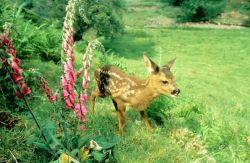We use some essential cookies to make this website work.
We’d like to set additional cookies to understand how you use forestresearch.gov.uk, remember your settings and improve our services.
We also use cookies set by other sites to help us deliver content from their services.

This journal paper investigates the factors that drive deer damage to woodlands using the National Forest Inventory sample square data. We found that the likelihood of damage to trees depends on cross-scale interactions between climate, deer density and landscape structure. The complex interactive effects uncovered are difficult to interpret. We...
• Novel dendrochronological modelling was developed to explore oak stem growth trends. • Trees with long-term AOD symptoms may have been predisposed many decades earlier. • Diseased trees struggle to take advantage of favourable growing conditions. • Historic episodes of stress may impact the future resilience of oaks to disturbance.
This paper summarises the results of Forest Research’s citizen science canopy cover webmap. Tree canopy cover was measured by contributors to the project in 5,749 urban wards in the UK using a random sample, manual image classification tool called i-Tree Canopy. The area-weighted mean canopy cover across urban areas in...
Summary of Programme The programme will pursue innovative approaches to forest inventories, data acquisition, high-quality forestry statistics and forest modelling in support of forest policy and practice. New methods will be developed and integrated to inform choices on forest capital. Sustainable forest management is only possible with the appropriate data...
Forest Yield: a PC-based yield model for forest management in Britain
This Research Note presents the findings of a study which examined how biodiversity changes with stand age, with a view to incorporating it into optimal forest rotation length modelling. The study reviewed relevant literature and analysed Forestry Commission Biodiversity Assessment Project data. The review revealed no simple or universal response...
This report outlines a study undertaken to estimate the potential flood storage provided by beaver dams during flood events, comparing this with existing man-made timber bunds to determine whether the beaver dams offer comparable storage volumes such that the eventual loss/failure of the timber bunds does not pose an increased...
The Land Use and Ecosystem Services Research Group provides services to the forestry and environment sectors in the following areas: Evidence & knowledge These services are focussed on generating ecological, environmental, and social evidence and knowledge. We do experimental work, talk to people, and derive new evidence from existing data. For example,...
Summary of the use of urban greenspace to reduce erosion control and surface runoff due to stabilisation by tree roots and grasses
Summary of Programme The move to a low carbon economy is expected to place an increasing demand on timber and forest products and there is a need to increase our domestic production to support sustainable economic growth in the sector. Increasing demand for sustainable construction and infrastructure materials as well...
Cookies are files saved on your phone, tablet or computer when you visit a website.
We use cookies to store information about how you use the dwi.gov.uk website, such as the pages you visit.
Find out more about cookies on forestresearch.gov.uk
We use 3 types of cookie. You can choose which cookies you're happy for us to use.
These essential cookies do things like remember your progress through a form. They always need to be on.
We use Google Analytics to measure how you use the website so we can improve it based on user needs. Google Analytics sets cookies that store anonymised information about: how you got to the site the pages you visit on forestresearch.gov.uk and how long you spend on each page what you click on while you're visiting the site
Some forestresearch.gov.uk pages may contain content from other sites, like YouTube or Flickr, which may set their own cookies. These sites are sometimes called ‘third party’ services. This tells us how many people are seeing the content and whether it’s useful.